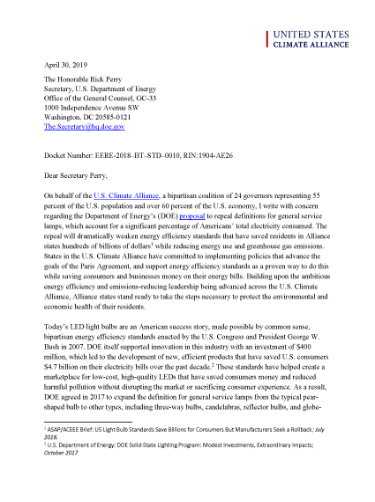Home / U.S. Climate Alliance Urges the Department of Energy to Withdraw their Proposal to Weaken Energy Efficiency Standards for Light Bulbs
- Letter
U.S. Climate Alliance Urges the Department of Energy to Withdraw their Proposal to Weaken Energy Efficiency Standards for Light Bulbs
April 30, 2019
The United States Climate Alliance has urged Secretary Perry and the U.S. Department of Energy to withdraw a proposed rule that dramatically weakens energy efficiency standards for general service lamps, which account for a significant percentage of Americans’ total electricity consumed.
The current standards have saved residents in Alliance states hundreds of billions of dollars while reducing energy use and carbon pollution. Energy efficiency standards are a proven, cost-effective tool to help states uphold the goals of the Paris Agreement while saving consumers and businesses money on their energy bills. Today’s LED light bulbs are an American success story, made possible by common sense, bipartisan energy efficiency standards. Alliance states stand ready to take the steps necessary to protect the environmental and economic health of their residents.
About the Alliance
Launched in 2017 by the governors of Washington, New York, and California to help fill the void left by the U.S. federal government’s withdrawal from the Paris Agreement, the Alliance has grown to include 24 governors from across the U.S. representing approximately 60 percent of the U.S. economy and 55 percent of the U.S. population. Governors in the Alliance have pledged to collectively reduce net greenhouse gas emissions by at least 26-28 percent by 2025, 50-52 percent by 2030, and 61-66 percent by 2035, all below 2005 levels, and collectively achieve overall net-zero greenhouse gas emissions as soon as practicable, and no later than 2050.
The Alliance’s states and territories continue to advance innovative and impactful climate solutions to grow the economy, create jobs, and protect public health, and have a long record of action and results. In fact, the latest data shows that as of 2023, the Alliance has reduced its collective net greenhouse gas emissions by 24 percent below 2005 levels, while increasing collective GDP by 34 percent, and is on track to meet its near-term climate goal of reducing collective greenhouse gas emissions 26 percent below 2005 levels by 2025.
###
